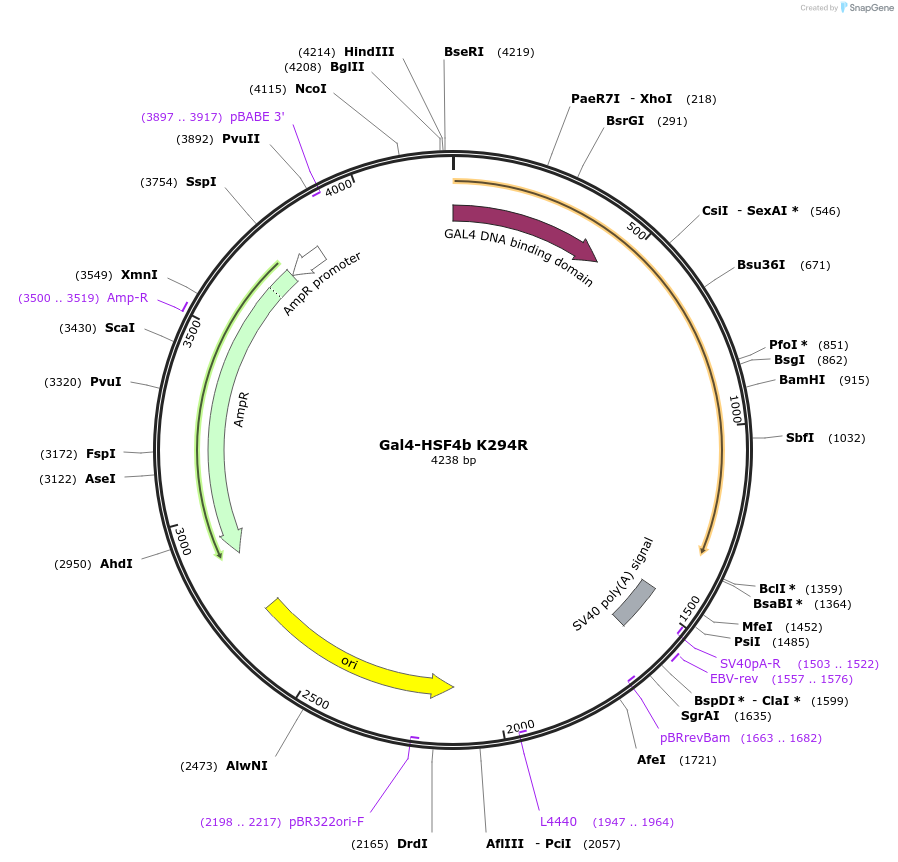Gal4-HSF4b K294R
(Plasmid
#118359)
-
PurposeThis plasmid expresses amino-acids 200-493 of hHSF4b K294R mutant fused to the GAL-4 DNA binding domain. This construct cannot undergo sumoylation on K294.
-
Depositing Lab
-
Sequence Information
Ordering
| Item | Catalog # | Description | Quantity | Price (USD) | |
|---|---|---|---|---|---|
| Plasmid | 118359 | Standard format: Plasmid sent in bacteria as agar stab | 1 | $89 | |
Backbone
-
Vector backbonepSG424
-
Backbone manufacturerSadowski and Ptashne
- Backbone size w/o insert (bp) 3396
-
Vector typeMammalian Expression
Growth in Bacteria
-
Bacterial Resistance(s)Ampicillin, 100 μg/mL
-
Growth Temperature37°C
-
Growth Strain(s)DH5alpha
-
Copy numberHigh Copy
Gene/Insert
-
Gene/Insert namehHSF4b
-
SpeciesH. sapiens (human)
-
MutationK294R
-
Entrez GeneHSF4 (a.k.a. CTM, CTRCT5)
Cloning Information
- Cloning method Restriction Enzyme
- 5′ cloning site EcoRI (unknown if destroyed)
- 3′ cloning site XbaI (unknown if destroyed)
Terms and Licenses
-
Academic/Nonprofit Terms
-
Industry Terms
- Not Available to Industry
Trademarks:
- Zeocin® is an InvivoGen trademark.
Depositor Comments
Transcript Variant: This variant (2) uses two alternate in-frame splice sites in the 3' coding region, compared to variant 1, resulting in a longer protein (isoform b). This variant, alternatively referred to as HSF4b, functions as a transcriptional activator of the constitutive expression of heat shock genes.
These plasmids were created by your colleagues. Please acknowledge the Principal Investigator, cite the article in which the plasmids were described, and include Addgene in the Materials and Methods of your future publications.
-
For your Materials & Methods section:
Gal4-HSF4b K294R was a gift from Lea Sistonen (Addgene plasmid # 118359 ; http://n2t.net/addgene:118359 ; RRID:Addgene_118359) -
For your References section:
PDSM, a motif for phosphorylation-dependent SUMO modification. Hietakangas V, Anckar J, Blomster HA, Fujimoto M, Palvimo JJ, Nakai A, Sistonen L. Proc Natl Acad Sci U S A. 2006 Jan 3;103(1):45-50. doi: 10.1073/pnas.0503698102. Epub 2005 Dec 21. 10.1073/pnas.0503698102 PubMed 16371476



